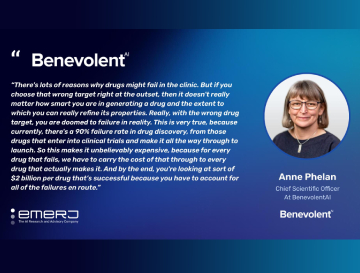In September I had the honour of sharing the stage at The Crick Institute with fellow EDIS (Equality, Diversity and Inclusion in Science and Health) representatives to discuss inclusive research and experimental design.
"I used this platform to advocate for the importance of including a more diverse population in research and the potential benefits of artificial intelligence in enabling this."
Mind the gap: the diversity issue in medical research
The data gap in clinical research is well documented, but now that AI methods are being applied at all stages of the drug discovery and development journey, the existing data gap in clinical research could be exacerbated if action is not taken now to diversify the pool.
Disease patterns, clinical presentation and therapeutic response are strongly influenced by factors such as gender, race/ethnicity, ancestral background and socioeconomic status. However, an analysis of drug studies shows that most participants in clinical trials are likely to be male and from western ancestries. Furthermore, we can see from recent advances in omics, for example in genome-wide association studies (GWAS), the data comes from a high percentage of patients with western ancestries. African DNA makes up less than 2% of genetic research material, despite people of African ancestry being more genetically diverse than all of the other populations in the world combined.
There are also examples where gender differences, when not taken into consideration during drug development programmes, have led to unnecessary adverse consequences for patients that could have been avoided. An example is Zolpidem which was approved for insomnia in 1992 with a label dosage of 10mg. It was not until after approximately 700 reports of impaired driving and road accidents were reported to the FDA, that the label was reviewed and revised to 5mg in women and 5 or 10mg in men.
As researchers, we need to ensure that our research reflects and represents the populations that are living with diseases and who are likely to benefit the most. If factors of gender, race, ethnicity, ancestral background and socioeconomic status are not accounted for in research, then the efficacy or safety of a drug is not fully known for significant sections of society. This means that patients may experience different side-effects or may fail to respond to treatments altogether.
But there are a number of positive strategic initiatives intended to include more diverse datasets in research, for example H3Africa aims to study genetic diversity in health and disease in African populations. The FDA Office of Women's Health also launched a Diverse Women in Clinical Trials Initiative to raise awareness on the need for more diverse women to participate in clinical trials. As we become more proficient in treating individuals rather than populations, these approaches are making good progress in ensuring everyone can benefit from advances in healthcare.
The potential for ai in drug development is huge
As my colleague Alix demonstrated in our last blog post, AI can enhance healthcare decisions and will play a great role in moving us towards a purposeful future. AI allows us to use and interpret vast diverse data sets, meaning we can combine data from clinical trials. Biomedical research could also be transformed by the ubiquity of digital and wearable technologies which bring potential benefits through image analytics and monitoring real world efficacy. That said, we still need to continue making efforts to diversify our data in order to ensure this innovation can be applied to the wider population.
A call to action
AI systems are only as good as the data they use. At Benevolent we have committed to raising awareness of the data gap issue and are proactively engaging stakeholders in order to shake up the status quo. We signed up to EDIS be part of a forum looking to challenge the diversity problem in medical research. However, there needs to be a complete paradigm shift at every stage of research; from when we identify which topic to study, to when we identify participants for clinical trials. By collaborating and engaging in collective action across the science and health sector, we can ensure that every patient can benefit from our innovations and discoveries.
Back to blog post and videos




